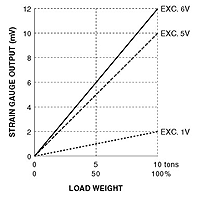 Without
otherwise specified, the excitation voltage of our strain gauge transmitters
is factory adjusted to 5V. Without
otherwise specified, the excitation voltage of our strain gauge transmitters
is factory adjusted to 5V.
As the rated output from the strain gauge in this question is 2mV/V, input
signal to the transmitter will be 0-10mV (2mV/V x 5V). If you change the
excitation voltage to 6V, input to the transmitter will be 0-12mV (2mV/V
x 6V). In other words, though the output from the strain gauge is actually
50% (5 tons), input signal to MXLCF will be 6mV (60% of 10mV span) with
6V excitation, and the indicator naturally displays 6 tons.
 To
have an output signal from the strain gauge, it is necessary to supply voltage
to it. This voltage is called excitation voltage. Recommended excitation
voltage of the strain gauges is MAX. voltage which satisfies their specifications
but is not always essential. Less voltage is available depending on the
transmitter's performance. In this case, you do not have to readjust the
excitation voltage to 6V, stay with the factory-adjusted 5V. To
have an output signal from the strain gauge, it is necessary to supply voltage
to it. This voltage is called excitation voltage. Recommended excitation
voltage of the strain gauges is MAX. voltage which satisfies their specifications
but is not always essential. Less voltage is available depending on the
transmitter's performance. In this case, you do not have to readjust the
excitation voltage to 6V, stay with the factory-adjusted 5V.
As M-System's strain gauge transmitters are equipped with the amplifier
which realized excellent performance with low excitation voltage, you can
have stable output signal with 4V excitation even if higher value is specified
in the specifications of a connected strain gauge. |
 Without
otherwise specified, the excitation voltage of our strain gauge transmitters
is factory adjusted to 5V.
Without
otherwise specified, the excitation voltage of our strain gauge transmitters
is factory adjusted to 5V. To
have an output signal from the strain gauge, it is necessary to supply voltage
to it. This voltage is called excitation voltage. Recommended excitation
voltage of the strain gauges is MAX. voltage which satisfies their specifications
but is not always essential. Less voltage is available depending on the
transmitter's performance. In this case, you do not have to readjust the
excitation voltage to 6V, stay with the factory-adjusted 5V.
To
have an output signal from the strain gauge, it is necessary to supply voltage
to it. This voltage is called excitation voltage. Recommended excitation
voltage of the strain gauges is MAX. voltage which satisfies their specifications
but is not always essential. Less voltage is available depending on the
transmitter's performance. In this case, you do not have to readjust the
excitation voltage to 6V, stay with the factory-adjusted 5V.